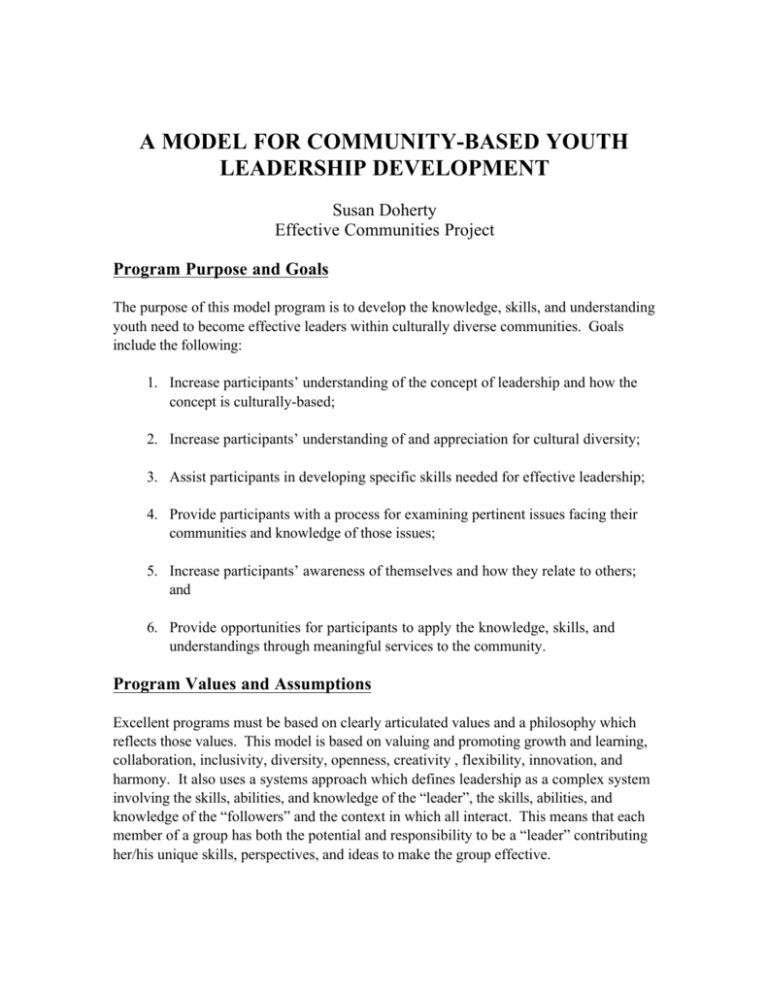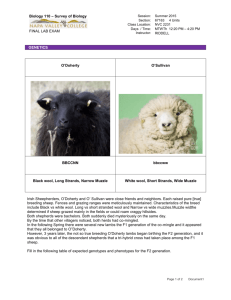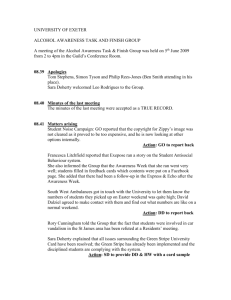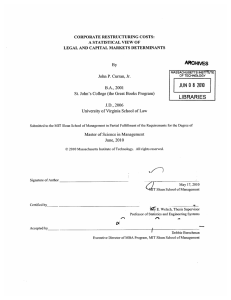a model for community-based youth leadership development
advertisement

A MODEL FOR COMMUNITY-BASED YOUTH LEADERSHIP DEVELOPMENT Susan Doherty Effective Communities Project Program Purpose and Goals The purpose of this model program is to develop the knowledge, skills, and understanding youth need to become effective leaders within culturally diverse communities. Goals include the following: 1. Increase participants’ understanding of the concept of leadership and how the concept is culturally-based; 2. Increase participants’ understanding of and appreciation for cultural diversity; 3. Assist participants in developing specific skills needed for effective leadership; 4. Provide participants with a process for examining pertinent issues facing their communities and knowledge of those issues; 5. Increase participants’ awareness of themselves and how they relate to others; and 6. Provide opportunities for participants to apply the knowledge, skills, and understandings through meaningful services to the community. Program Values and Assumptions Excellent programs must be based on clearly articulated values and a philosophy which reflects those values. This model is based on valuing and promoting growth and learning, collaboration, inclusivity, diversity, openness, creativity , flexibility, innovation, and harmony. It also uses a systems approach which defines leadership as a complex system involving the skills, abilities, and knowledge of the “leader”, the skills, abilities, and knowledge of the “followers” and the context in which all interact. This means that each member of a group has both the potential and responsibility to be a “leader” contributing her/his unique skills, perspectives, and ideas to make the group effective. The model is also based on several assumptions. The first is that leadership development is important because it provides members of a group with the skills, knowledge and abilities they need to more effectively work together to deal with issues facing a community or group, and that the more skilled the members of the group are, the more likely the group will be to develop creative and successful solutions to difficult issues. A second assumption is that youth are capable of developing their leadership potential through the same processes (e.g. analyzing issues, increasing self awareness, developing skills, applying learning, etc.) as adults. This model assumes that youth are capable of and can benefit from developing leadership and using that leadership to analyze community issues, determine strategies for dealing with those issues, and implement action plans. A third assumption is that people learn in different ways. This makes it important that learning activities address a variety of learning styles. Programs must be designed to actively involve participants in a variety of experiences and assist them in learning from those experiences. Participants thus have the opportunity to acquire and actively practice new skills. A fourth assumption is that participation in the “global society” of the 21st century will require people to appreciate and build on diversity, and to know how to work cooperatively and collaboratively with a variety of people. Programs must stress cooperative group activities and development of skills to build on the unique knowledge and abilities of all group members in ways that value and appreciate diversity. The final assumption is that effective implementation of programs requires involvement of the people affected by those programs, including youth. This requires an inviting and inclusive mindset on the part of program planners, and means that those affected by a program must be involved from the early planning stages through the final implementation and evaluation. © Susan Doherty March, 2003 Effective Communities Project Page 2 Community Involvement Broad-based community involvement is essential to a community leadership development program. This youth leadership program should be guided by a committee consisting of representatives of human service agencies, education, religious institutions, business, ethnic/cultural groups in the community, and other groups which have an interest in youth development. Involvement of a broad base of community members in the planning, implementation, and evaluation of the program should ensure that 1) the program will be relevant to the community’s needs; 2) the program will address the culturally diverse values and perspectives of the community; 3) the program will be supported by a large segment of the community; 4) community members will become more aware of youth issues and supportive of youth in the community; and 5) community members will increase their own community leadership development through their participation in the program. In this way, the program impacts not only the youth who are program participants but also community members who work with youth. Program Participants This model is designed to directly involve youth ages 14-19. This age group targets youth who are old enough and mature enough to comprehend the complexity of skills, knowledge, and understanding needed for effective leadership; to have a basic knowledge of the community in which they live and the issues facing that community; and to have the intellectual capability, creativity, and human relations skills to be involved in planning and conducting service projects in the community. It is important that participants be chosen through a selective application and interview process. This ensures that participants are strongly motivated to be actively involved, that they are committed to participate in all program activities, and that the community and their peers recognize their motivation, commitment and potential. © Susan Doherty March, 2003 Effective Communities Project Page 3 Cultural Appreciation An emphasis on cultural diversity in values, approaches to leadership, and expected behaviors would be infused throughout the program. This includes a recognition of different ways of defining leadership, of communicating, of valuing doing and being, of being comfortable with sharing thoughts and feelings with others, of placing importance on humility, and of dealing with conflict. Such differences must be acknowledged in program planning, incorporated into program design, and openly acknowledged by participants, staff, and community members involved in the program. At opening activities for the program, major emphasis would be placed on appreciating cultural diversity. One of the first activities at the retreat would be development of a set of norms to guide participants’ behavior throughout the program. Suggested norms would include acknowledging cultural differences and tolerating misunderstandings based on those differences. This should help to set the stage to acknowledge and deal with the differing perspectives and values which people from different cultures bring to any situation. Experiences designed to increase cultural appreciation should focus on developing cultural self awareness, comparing cultural characteristics, and developing categories for analyzing cultural difference. Participants would participate in a simulation designed to point out the effects of culture on behavior. Participants would also examine their own culture based on Condon and Yousef’s model of cultural values. Students would describe their culture’s view of leadership, the kinds of characteristics and behaviors expected of both leaders and followers and ways in which that view is and is not compatible with the Western cultural view of leadership. Throughout the rest of the program, attention would be paid to the diverse perspectives different cultures bring to various issues, and to the need to appreciate and build on these perspectives. This applies to prioritizing the skills to be taught through the program, to determining issues to examine in the community and ways in which to approach those issues, to designing approaches to facilitating self awareness and understanding, and to developing an atmosphere of trust and support. © Susan Doherty March, 2003 Effective Communities Project Page 4 Skills and Knowledge A specific training design would be developed to list the key concepts to be presented, state specific behavioral objectives (e.g., the participant will be able to...), list learning activities to ensure that behavioral objectives are met, and identify presenters/resource people, time requirements, equipment and supplies needed. Design would include a variety of methodologies to deal with the cognitive and affective domains and to use Kolb’s experiential learning cycle to meet the learning styles of all participants. In general, methodologies would call for participants to identify elements of an experience (either structured into the training or based on participants’ life experiences), reflect on and analyze the meaning and usefulness of the experiences, and generalize about how to apply the knowledge, skills, and understandings in other situations. The curriculum should incorporate two specific areas: leadership skills and knowledge of issues. Leadership Skills. One of the first concerns regarding the general topic of leadership is to discuss what the term means. Participants would be encouraged to share personal and cultural values and ways in which values affect views of leadership. Possible leadership skills to be covered through the program would include dealing with change, improving communication, managing conflict, making decisions, building effective groups, managing meetings, planning and strategizing, and solving problems. Knowledge of Issues. Youth would list issues facing the community which they found important. Emphasis would be placed on examining all sides of an issue and on examining the implications of differing cultural values on the issue. Methodologies might include debates or point/counterpoint discussions by community members involved with issues or debates in which teams of youth present all sides of an issue. Youth would thus learn not only about specific issues, but also about a process to use in examining any issue. Self Awareness One of the major psychological issues for adolescents is developing a better understanding of themselves. This means that the component of self awareness is crucial to a youth leadership development program. Youth would be given time to reflect on their own values, talents, and skills and ways in which they could best use their abilities to provide service for others. Attempts would also be made to place individual values and goals into a cultural context to assist youth in better understanding the impact of their cultures on their own values and plans. © Susan Doherty March, 2003 Effective Communities Project Page 5 Throughout the program, participants would be encouraged to develop an awareness of the impact they have on others. Youth would also be encouraged to keep journals and to reflect on what they’ve learned about themselves and how they relate to others. At the final session, particular emphasis would be placed on discussing the impact each member had on the group, the contributions he or she made, and the growth and development others’ saw him or her make through the program. The groups would also discuss ways in which leaders can deal with stress and can renew themselves on an ongoing basis. Application of Learning Application of the skills, knowledge, and understanding gained through the program is essential to ensure that participants learn to generalize and apply what they’ve learned in other situations. This leadership development program model calls for two ways in which participants would apply their learning: through community service projects and through mentorships. Participants would identify various needs in the community, prioritize and choose a specific area in which to work, and would work in small groups to design a specific project, implement and evaluate the project. Through this process, they would become more involved in the community, feel a sense of their part in the community, and provide a real service. Staff would facilitate the process in which groups of students select priorities and design projects, implement these projects, and evaluate the group’s effectiveness in carrying out this process. The mentorship component of the program would match participants with community members who would serve as models, guides, coaches, and confidants for the youth. Mentor-participant relationships would vary depending on the needs and goals of the particular pairs. Mentors might assist program participants in developing specific skills, meeting particular people in the community, and providing support for overall personal and leadership development while youth are involved in the program. Staff would recruit potential mentors and provide training regarding the mentor’s role. Staff would also match mentors with participants, and would facilitate the process of having the pair negotiate what each would contribute to and ask of the relationship. Feedback and Support Feedback and support, key elements in any leadership development program, are crucial to a program designed for adolescents who tend to be concerned about who they are and how others perceive them. It is important that an atmosphere of trust and acceptance be developed so that participants are comfortable with both giving and receiving feedback. The opening session would emphasize shared norms regarding feedback as well as © Susan Doherty March, 2003 Effective Communities Project Page 6 development of trust and a team spirit among participants. Physical challenges such as orienteering and initiative games and trust building activities such as a verbal boundary breaking activity would model these norms. Structured risk-taking experiences build both self confidence and group solidarity. Participants would also be provided with information on the process of giving and receiving feedback, and would be given the opportunity to practice the process. Staff and community members involved in the program would also give (and receive) constructive feedback regarding skills, how individuals are perceived, and their effectiveness as leaders. These adults would also be encouraged to develop supportive relationships with participants to help youth deal with the stresses of adolescence and leadership, to share accomplishments, to assist in problem solving, and to share information on other resources available in the community. It is important that participants recognize the other support networks available to them. During the program, participants would examine the support network they already have, including friends, family, teachers, counselors, etc., and would discuss ways in which they can seek the support they need. Emphasis would also be placed on ways in which one can effectively provide support for others. Evaluation Each participant would complete a written evaluation for the program. Evaluations would focus on the program’s usefulness, the relevance of information presented and suggestions for changes to increase relevance, and on ways in which participants might apply what they learned. At the final session, current participants, past participants (once the program has been in existence for a year), session presenters and facilitators, committee members, and staff would all participate in an oral evaluation of the overall program. Input from this session would be used in designing the next year’s program. A third-party evaluation of the entire program would also be conducted to provide objective information on the program’s success in meeting program goals. © Susan Doherty March, 2003 Effective Communities Project Page 7 Summary This model program attempts to bridge a gap between theory on leadership, community leadership, culturally ethnorelative concepts of leadership, and leadership development with actual practice in leadership development for youth. It is hoped that implementation of such a model and subsequent evaluation of the model’s success would provide still more information which could be used to improve both the specific program and similar community-based youth leadership development programs. © Susan Doherty March, 2003 Effective Communities Project Page 8







